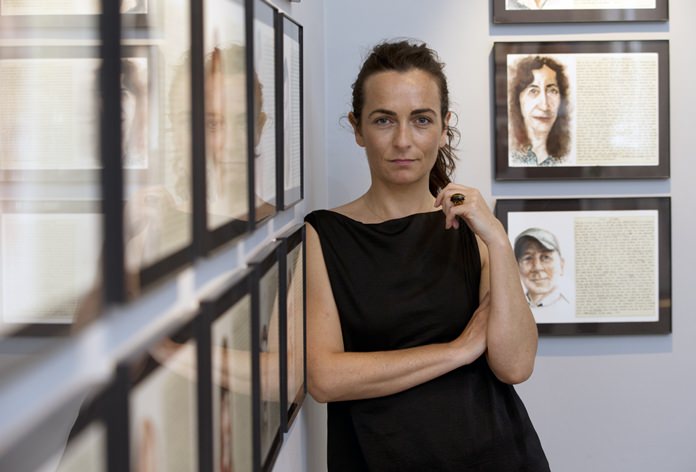Boston (AP) – New to Boston, Parisian artist Aurélie Galois took a deep breath, gathered her oil paints and ventured forth on a unique mission to get acquainted with her adoptive city: Every Friday, for an entire year, she painted a portrait of a stranger.

Along the way, she poked holes in her own preconceptions about Americans. The results — “Friday Face,” a collection of all 52 spontaneous works and the poignant handwritten vignettes Galois scribbled about each of her subjects — are on display at the French Cultural Center in Boston.
“When you move to the U.S., you think you know the American culture but you don’t — it’s only what you know from famous people,” she said. “After a while, you realize it’s a very exotic place. I got to know Boston better just by encountering people and being very observant. I realized this country is made up of people, not clichés. Every person broke down a stereotype.”
Galois, 38, began the project as an experiment in May 2014, not long after moving to Massachusetts with her Harvard University scientist partner and their children.
Craving conversation, she was a regular at a local café when she realized the strangers around her were a means of discovery.
She started with no particular aim, introducing herself, snapping a few iPhone photos for reference, and chatting up her new friends for two or three hours, taking notes as they confided in her. Her questions, she said, weren’t softballs: “Tell me about your parents. Tell me about where you were born. Tell me about what your dreams were as a kid.”
Amazingly, not a single person she approached shut her down — something she doubts could have happened back in Paris, where she worked as a magazine editor and journalist.
“It was extraordinary,” Galois said. “They told me things they never told anyone else. Many times I had goosebumps.”
Back in her studio near Fenway Park, she painted quick, loosely rendered portraits. Each is paired with a single page of her observations, written in nearly flawless English.
“I love faces. Nothing fascinates me more than the human face,” she said. “I was like a vampire: ‘This lip is like this; that eyelid is like that.’ I wanted to catch their essence. You know how when you close your eyes, you have an image of a person? That’s always the one I paint.”
After about 10 portraits, Galois realized she had the makings of an exhibition. Without intending to, she had captured a cross-section of society very diverse in age, gender, race, ethnicity, faith and sexual orientation.
Her subjects ranged from South African-born kosher butcher Louis Bolnick to black oncologist Karen Winkfield and renowned novelist and poet Joyce Carol Oates.
Visitors to “Friday Face,” on show through July 2, say they’re moved by the humanity the 52 portraits and vignettes represent.
“It’s absolutely fascinating. I’ve never seen anything like this before,” said Kathleen Horstmeyer, of Chester, Connecticut, touring the exhibition this week. “It takes a lot of confidence to invite strangers into your conversations.”
Galois said she discovered some common threads that became the ties that bind these snapshots: a sense of American patriotism and optimism; the gratitude of those who have immigrated here; the surprising preponderance of tattoos.
“It’s really interesting when an individual artist comes up with a wild project and then sees it through,” said one of Galois’ subjects, Jason McCool, 41, a doctoral student in musicology. “You don’t have to ask for permission to make art — you just do it. She’s got people talking. It’s amazing.”
As Galois mulls whether to take her show on the road, she’s also considering a sequel — possibly one more sharply focused on a specific demographic such as young people or women, featuring larger-format portraits coupled with video.
“Each of them is different. They all have a different story,” she said. “When I look at them, I remember their stories. It’s extraordinary what they gave me.”




